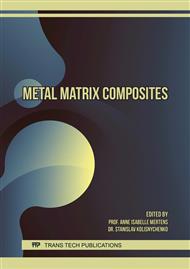p.59
p.65
p.73
p.79
p.87
p.94
p.100
p.106
p.115
Investigation of the Creep Resistance of a Spray-Compacted Si-Particle Reinforced Al-Based MMC (Dispal® S270)
Abstract:
MMCs exhibit a high potential in modern structures due to many positive attributes. One of these attributes is a heightened creep resistance compared to conventional single or multi-phase alloys. The following paper focuses on the creep resistance of a spray-compacted Al-based alloy (DISPAL® S270). This alloy, designed for high temperature applications like turbochargers, cylinder bore liners or pistons can be subjected to temperatures up to 450°C, which is considerably higher compared to unreinforced Al-alloys. DISPAL® S270 microscopically consists of Si-particles with round shapes in an Al-rich α solid solution, which is additionally reinforced by complex precipitates, including Al9FeNi and Al3Ti, among others. The particle sizes and ratios differ with the heat treatment. The same applies to the precipitates in the matrix. The investigated heat treatments are F (after extrusion) and T6 (additional peak aged). The alloy is tested at 250°C using different loads at constant force with stress values between 125 and 200 MPa. The measured minimal creep rates are in the range of min. = 10-5-10-8 1/s. In comparison to conventional single or multiple phase alloys MMCs reveal some advantages, since the modified threshold stresses and direct strengthening often reduce the minimum creep rate. The stress exponent of the MMCs has higher values compared to aluminum alloys, as known from previous MMC studies. The specimens are analyzed with LM, SEM, EDS and XRD. It could be shown that an additional heat treatment (peak aged T6) enhances the creep properties by introducing very fine precipitates containing the Mg5Si6 phase.
Info:
Periodical:
Pages:
87-93
Citation:
Online since:
June 2019
Authors:
Price:
Сopyright:
© 2019 Trans Tech Publications Ltd. All Rights Reserved
Share:
Citation:



